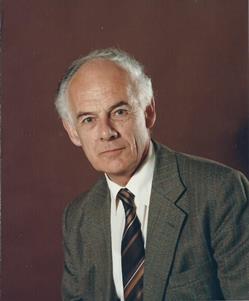 Pioneer of modern carbonate sedimentology who joined his father's firm (V C Illing & Partners) and worked with many other greats on the dolomitization problem.
Pioneer of modern carbonate sedimentology who joined his father's firm (V C Illing & Partners) and worked with many other greats on the dolomitization problem.
Leslie was born on November 1920 in Wimbledon. He attended the City of London Freemens's School, Ashtead and Epson College. He studied geology at Sydney Sussex College Cambridge, but his studies were interrupted by the war when he served in the Royal Air Force. Later he spent two terms at the Royal School of Mines before returning to finish his studies at Cambridge with First Class Honours in 1947.
Bahamas
He joined Seismic Services Corporation, Venezuela and during a survey of the Bahamas collected bottom samples at each shot point - the material for his future PhD studies at Cambridge with Maurice Black, which he completed in 1949.
Leslie's work on the Bahamas together with that of Newell and Purdy and that of Robert Ginsburg in Florida Bay and the reef tract lead to a surge in interest in carbonate sediments and the interpretation of ancient carbonate sequences.
After completion of his PhD he joined Pemex (Petroleos Mexicanos) and studied the Tambara limestone of Poza Rica, Mexico and later the Cretaceous sequence of Guarico Venezuela for Caracas Petroleum. Later he studied the Paleozoic carbonate sequences of Western Canada for Shell. He argued the changes from limestone to dolomite in the Mississippian rocks was produced by movements of fluids through a chain of reefs. He thus introduced the concept of dolomitization by escaping compaction waters.
V C Illing & Partners
In 1960, Leslie with his wife and four sons returned to the UK to join his father's company V.C. Illing and Partners and assumed control of its management in 1968. Here he continued his work on carbonate sequences. Together with J.C.M. Taylor he made a comprehensive survey of the Zechstein carbonates of the North Sea for BP and made further studies in the North Sea for Ultramar, British Gas and others in Libya, other Middle East countries including the Devonian reefs of Algeria with SPNA.
In the 1960s Leslie, John Taylor and Roger McQueen investigated together with Alan Wells and Vic Colter of Shell the modern dolomitization in the saline intertidal-flat deposits of Qatar, Persian/ Arabian Gulf. The association of dolomite and evaporite was reminiscent of many of the rocks Leslie had studied previously: the Mississippian of Western Canada, the Jurassic of Mexico and the Middle East, the Cretaceous of Guatemala and the Tertiary rocks of Libya.
The reduction of exploration by oil companies, after the collapse of oil prices, led to V.C. Illing and Partners closing in 1987.
PESGB
In addition to his consulting and research work Leslie was a keen supporter of the Petroleum Exploration Society of Great Britain (PESGB). He served on its committee and was its Chairman in 1975 and represented the society on the Organising Committee of the first two North Sea Geological Conferences of 1974 and 1980. Together with the late Douglas Hobson (his father's old colleague) he edited the proceedings of the latter. Finally, the Society honoured him by making him an honorary member.
Leslie was a quietly spoken, very kind, courteous person always willing to listen critically to new ideas. He had a formidable task following such an eminent father, but he did this with great success. Leslie must be considered, in view of his Bahaman and Persian/ Arabian Gulf work, as one of the pioneers of modern carbonate sedimentology whose work led to a more sophisticated interpretation of ancient carbonate sequences. His death in January 2018 was preceded by that of his wife Edith in 2017 and he is survived by four sons, four grandchildren and one great grandchild.
By Graham Evans